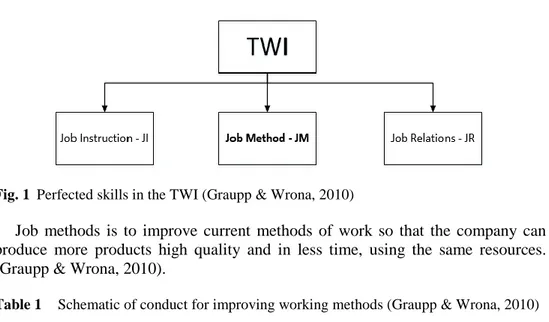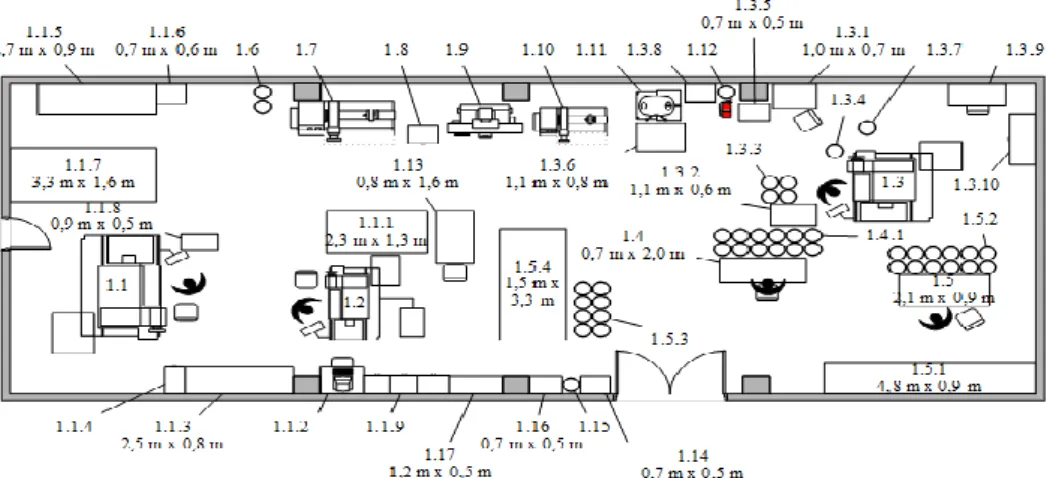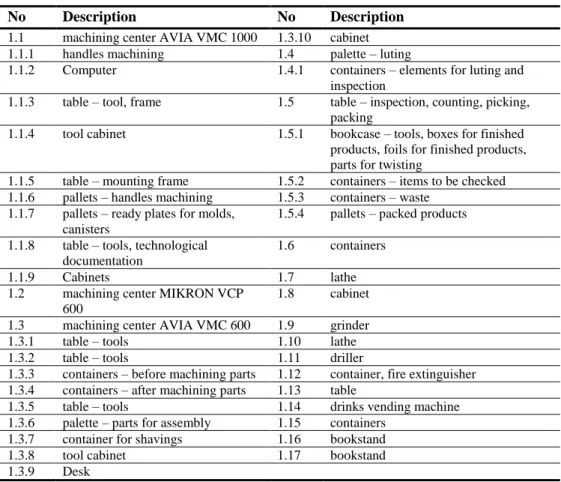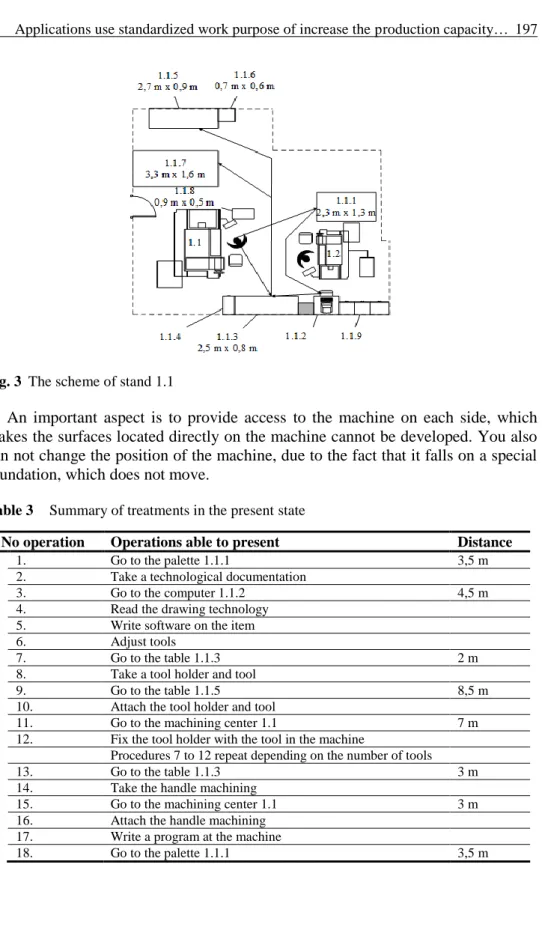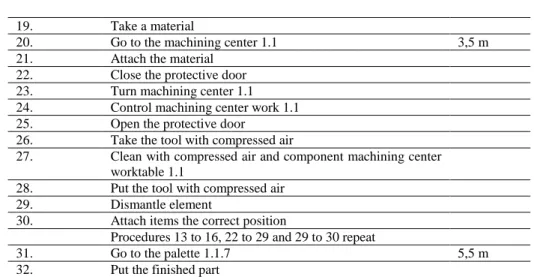APPLICATIONS USE STANDARDIZED WORK
PURPOSE OF INCREASE THE PRODUCTION
CAPACITY – A CASE STUDY
Paulina Rewers* Michał Mandziuk* and Justyna Trojanowska**
* Faculty of Mechanical Engineering and Management, Poznan University of Technology, Poznan, 60-965, Poland, Email: paulina.rewers@wp.pl
** Department of Management Production and Engineering, Faculty of Mechanical Engineering and Management, Poznan University of Technology, Poznan, 60-965, Poland,
Email: justyna.trojanowska@put.poznan.pl
Abstract The article presents the results of research carried out in the company of the foundry industry.
Actions taken in the company were to analyze the losses occurring at selected positions and the implementation of standardized work procedures to improving the production process. Describes the state of the current position and manner of operations by the employee, taking into account the distances driven during the execution of the various treatments. The article presents the objectives of the program TWI (Training Within Industry), with special emphasis of the program on the improvement of working methods (MP). The proposed solutions are designed to improve working conditions in the enterprise, and shortening the distances that overcomes the operator also contributes to increased safety. The main effect introduced in the enterprise improvement activities is to increase employee productivity by reducing the execution time of repeated treatments with the introduction of standardized work rules.
Paper type: Research Paper
Published online: 30 April 2015
Vol. 5, No. 2, pp. 191-200 ISSN 2083-4942 (Print) ISSN 2083-4950 (Online)
© 2015 Poznan University of Technology. All rights reserved.
(Birmingham, 2007). Pursuit of this objective allows the concept of Lean Manufacturing (LM), whose tools help eliminate waste and increase productivity. The roots of Lean Management best practices date back to the production of the late nineteenth century., And the first half of the twentieth century. Prototype of the concept of Lean Manufacturing was the Toyota Production System, which was established after World War II with a combination of different methods, techniques and principles, including quality management solutions J. Juran and Japanese practitioners, ie. T. Ohno, E. Toyoda, S. Shingo. The concept of Lean is based on eliminating waste, and one of the tools LM standardized work, which is documented, is currently the best method to work.
Standardization ensures the implementation of each process in the same way by all staff. This is especially important from the point of view need to ensure consistent quality of our products. Standardization allows execution of orders within the prescribed time schedule, thus eliminating arbitrariness in the order of their execution.
The standardization process consists of several stages (Marciniak, 2006): • classification - grouping by similarity of product characteristics,
• unification - unification of design features and dimension machine elements in order to allow their interchangeability,
• typification - harmonize the structure in order to simplify production, reduce costs and facilitate operation.
This article presents the results of the manufacturing companies of the foundry industry analysis situation search for losses occurring on the selected workstation using the TWI program.
2. IMPROVEMENT OF METHODS OF WORK
Job methods (JM) is part of the development of the necessary skills superiors TWI. This program aims to develop key competences superiors that are needed to effectively manage the operational teams (Misiurek, 2014). It is divided into three basic parts shown schematically in Figure 1.
Fig. 1 Perfected skills in the TWI (Graupp & Wrona, 2010)
Job methods is to improve current methods of work so that the company can produce more products high quality and in less time, using the same resources. (Graupp & Wrona, 2010).
Table 1 Schematic of conduct for improving working methods (Graupp & Wrona, 2010)
HOW PERFECT
Methods of work
STEP 1 - SHARE WORK
1. Create a list of all the procedures exactly as they are performed today.
2. Make sure that the written procedures include everything, ie .:
movement of materials, working machine, manual labor.
STEP 2 - ASK FOR EACH TREATMENT
1. Use the following questions: WHY this treatment necessary? WHAT is the purpose of this procedure? WHERE this treatment should be done? WHEN perform this procedure? WHO is best qualified to perform this procedure?
WHAT is the best way to do this procedure? 2. Ask the same time of:
Materials, Machinery, Equipment, Tools, Solutions Design, Location jobs, Moving, Security, Order
STEP 3 - DEVELOP A NEW METHOD
1. ELIMINATES unnecessary treatments. 2. AMALG treatments where possible. 3. REARRANGES the sequence of treatments
that work easier.
4. SIMPLIFIES all required procedures, so to make work easier and safer:
place the materials, tools and equipment in the best place and so that it does not comfortably reach the operator;
use trays or gravity chute whenever possible; use both hands to work;
use brackets or mounts instead of hands. 5. DISCUSS your ideas with OTHER
EMPLOYEES.
6. DESCRIBE new method.
STEP 4 - Implementation NEW METHOD
1. SELL proposed method your boss. 2. SELL new method for operators.
3. Get final consent, taking into account issues: safety, quality, quantities, cost, etc
4. IMPLEMENTATION of the new method. Use it until you will develop a better method. 5. Praise, when appropriate.
To improve work is primarily used method 4 steps MP. Step 1: divide the work
Perform a detailed list of all treatments occurring during the execution of work. The greater the detail list, the more efficiently will improve.
5. Who is best qualified to perform this procedure? 6. What is the best way to do this procedure?
Step 3: develop a new method
Create a plan for change, in which there will be new ideas. The plan should include ways to improve work. These are:
1. Elimination of unnecessary treatments. 2. Combining treatments when possible.
3. Reorganization of the sequence of treatments. 4. Simplification of all procedures performed.
Ask other people, for example. Boss, or operators to help improve the work. Step 4: deploy the new method
After developing a new method should be well advertise - boss and operators. Introduce the abstract idea, which should include the division of labor sheets, examples, data, sketches, drawings, photographs and any other material allowing for the presentation of proposed changes. Then get final approval for the implementation of the project. You must also take into account issues of safety, quality, quantity, cost, etc.. Once you have agreed, as soon as you deploy the method and use it until you will develop better. You should also commend those who actively participated in the creation of new working methods (Graupp & Wrona, 2010).
Procedure scheme while improving working methods are shown in Table 1.
3. CHARACTERISTICS OF THE ENTERPRISE
The main activity of the analyzed production company is casting aluminum alloy parts for the automotive industry. Castings, ordered in small quantities, are mainly in sand molds and gravity casting die, while the castings produced in series - pressure method. The company also has a tooling department, which is the provider of services for CNC machines. Executed orders among others molds pressure injection equipment for the production of disposable packaging.
Thanks to the cooperation with major automotive customers analyzed company notes a continuous increase in orders for its products. In order to increase their competitiveness in the market, the company has decided to start work related to the improvement of production organization, aiming to increase their production potential. One of the areas of action was to increase the efficiency of manufa-cturing processes through the analysis and improvement of working methods.
The company includes such sections as: • administration department,
• tool department,
• department foundry the chill mold, • department pressure foundry, • department machining I, • department machining II.
This article presents the results of tests carried out on tooling department, where and how offers execution services for CNC milling machine, hole drilling machines, wire cutter and CNC lathe (company Avia, Mikron Agie, Charmilles, AgieAgietronSpirit, such as:
• performance of injection molds,
• performance of equipment for the production of disposable packaging, • implementation of specialized equipment,
• execution of pressure molds,
• consultancy in the design, modeling and creation of structures.
4. METHODS OF ANALYSIS AND IMPROVEMENT OF WORKING
FOR CHOOSING THE WORK BENCH
At the department there are three tool-machining centers. Diagram of the room in which the faculty tooling shown in Figure 1. The position of 1.1 and 1.2 of the production molds used for the casting process, while position 1.3 is designed for the manufacture of products offered by the company. In the room there is also a position of control products. Additionally, in the same room are stored finished goods awaiting dispatch.
1.1.3 table – tool, frame 1.5 table – inspection, counting, picking, packing
1.1.4 tool cabinet 1.5.1 bookcase – tools, boxes for finished products, foils for finished products, parts for twisting
1.1.5 table – mounting frame 1.5.2 containers – items to be checked 1.1.6 pallets – handles machining 1.5.3 containers – waste
1.1.7 pallets – ready plates for molds, canisters
1.5.4 pallets – packed products 1.1.8 table – tools, technological
documentation
1.6 containers
1.1.9 Cabinets 1.7 lathe
1.2 machining center MIKRON VCP 600
1.8 cabinet 1.3 machining center AVIA VMC 600 1.9 grinder
1.3.1 table – tools 1.10 lathe
1.3.2 table – tools 1.11 driller
1.3.3 containers – before machining parts 1.12 container, fire extinguisher 1.3.4 containers – after machining parts 1.13 table
1.3.5 table – tools 1.14 drinks vending machine 1.3.6 palette – parts for assembly 1.15 containers
1.3.7 container for shavings 1.16 bookstand
1.3.8 tool cabinet 1.17 bookstand
1.3.9 Desk
Explanation of signs used in Figure 2 are shown in Table 2.
4.1. Analysis of the current situation
The analysis position 1.1 (Fig. 3), which are produced in the modern machining molds for die-casting and pressure. This was done with a list of procedures performed taking into account the position of the distance traveled by the employee (Tab. 3).
The position of 1.1 working one operator with the appropriate skills to work on the machining center. Is required from him knowledge of 3D modeling software. The analyzed position produced only form of reusable assist in the production range offered by the company. Analysis of the situation showed that the employee overcome long distances between individual elements of the position, because of their location in the room and improper placement of certain tools or handles. Another problem is the position of the table 1.1.5, is located away from the machine and to which the operator approaches often.
Fig. 3 The scheme of stand 1.1
An important aspect is to provide access to the machine on each side, which makes the surfaces located directly on the machine cannot be developed. You also can not change the position of the machine, due to the fact that it falls on a special foundation, which does not move.
Table 3 Summary of treatments in the present state
No operation Operations able to present Distance
1. Go to the palette 1.1.1 3,5 m
2. Take a technological documentation
3. Go to the computer 1.1.2 4,5 m
4. Read the drawing technology 5. Write software on the item 6. Adjust tools
7. Go to the table 1.1.3 2 m
8. Take a tool holder and tool
9. Go to the table 1.1.5 8,5 m
10. Attach the tool holder and tool
11. Go to the machining center 1.1 7 m
12. Fix the tool holder with the tool in the machine
Procedures 7 to 12 repeat depending on the number of tools
13. Go to the table 1.1.3 3 m
14. Take the handle machining
15. Go to the machining center 1.1 3 m
16. Attach the handle machining 17. Write a program at the machine
27. Clean with compressed air and component machining center worktable 1.1
28. Put the tool with compressed air 29. Dismantle element
30. Attach items the correct position
Procedures 13 to 16, 22 to 29 and 29 to 30 repeat
31. Go to the palette 1.1.7 5,5 m
32. Put the finished part
4.2. Proposals for improvement activities
Due to the fact that the observations have shown that the table 1.1.5 is too far away from the workstation proposes improvement activities. Proposed setting the table 1.1.5 in place of 1.1.1 pallets, which in turn are presented in place of the current position of the pallet 1.1.7, to which she approaches the least likely. Palette 1.1.7 therefore postponed in place of table 1.1.5. The proposed changes are shown in Figure 3 also established that the palette 1.1.1 there will be only plate to form - both worked and unworked. 1.1.7 On the palette, but will be placed canisters of liquid machines and other rarely used.
4.3. Analysis of the results of the changes
The proposed solutions have focused on perfecting the activities performed by the employee during the performance of work, as shown in Table 4 distance which the operator must travel, in four cases will increase by 2 m, but the treatment, the implementation of which requires overcoming a long distance, are carried out sporadically. Has shortened the distance necessary to overcome in the case of the treatments 9 and 11, which are performed repeatedly. In both cases, the gap was left reduced by 4 m. Proposed amendments shortened the execution time of a component, by shortening distances by the employee in the various treatments.
Table 4 Changes in the distance defeated by the operator during the procedure to be
performed
No operation
Operations able to present Distance New distance
1. Go to the palette 1.1.1 3,5 m 5,5 m
3. Go to the computer 1.1.2 4,5 m 6,5 m
9. Go to the table 1.1.5 8,5 m 4 m
11. Go to the machining center 1.1 7 m 3 m 18. Go to the palette 1.1.1 3,5 m 5,5 m 20. Go to the machining center 1.1 3,5 m 5,5 m
31. Go to the palette 1.1.7 5,5 m 5,5 m (go to the palette 1.1.1)
5. CONCLUSION
Research conducted in the company were related to the definition of the tasks carried by employees to eliminate waste and increase productivity of individual operators. Results of this study was to propose, develop and implement changes in organization work and production space, which contributed to a significant shortening of the time of most of the operations. The company presented proposals costless changes in the organization of equipment at workplaces. The proposed solutions have contributed to a significant shortening implementation of key operations, as well as improved conditions of work by getting more space. In addition, the effect of the changes was to improve the safety and health at work.
Reduced time to complete each operation resulted in the release of additional capacity and enabled the company implementing more orders.
REFERENCES
Birmingham F., & Jelilnek J., (2007), Quick Changeover Simplified The Manager’s to Improving Profits with SMED, Productivity Press, New York.
